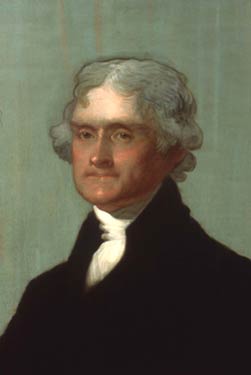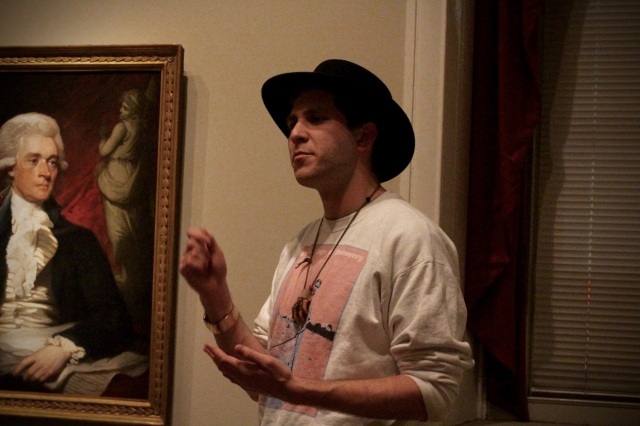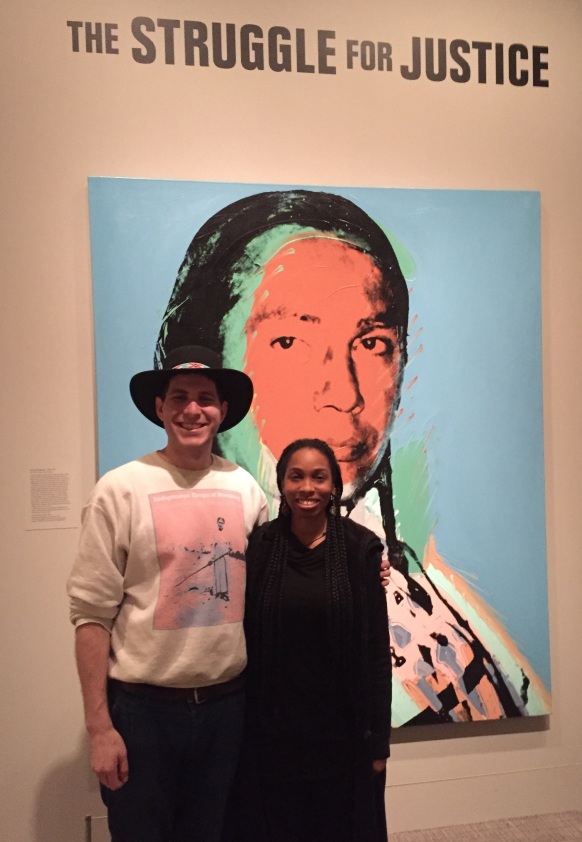A guest post by Laura Macaluso
Last week two very different tours of portraits of American presidents were offered on the same day, in the same city: Washington, D.C., the capitol of the United States since 1790, when Thomas Jefferson, James Madison and Alexander Hamilton made their compromise (in, you know, “The Room Where It Happened.”) Only in the capitol city could two such different tours occur. The first was “The Brush Stops Here: Portraits of Presidents” at the National Gallery of Art on the Mall. The second was the Indigenous Corps of Discovery’s tour of “America’s Presidents” at the Smithsonian’s National Portrait Gallery, a few blocks up from the Mall at the edge of Chinatown.
The first stop, the National Gallery of Art, stuns with its over-scaled rich Classicism—black marble columns, Corinthian capitals, and bronze statues—and stunning collection of world famous art, including portraits of the first American presidents.

Portraits of the first three American presidents: Washington, Adams and Jefferson, Gilbert Stuart, ca. 1821. National Gallery of Art. Photograph by author.
The National Portrait Gallery, in contrast, is located in the country’s first national patent office building—a rehabilitation/reuse project that dates to the 1950s, when the Greek Revival structure was threatened with demolition.
There is no way to compete with the collections of the National Gallery, in terms of its portraits of presidents. The gallery has the first presidential painting done of George Washington and his family—his enslaved butler William Lee is there too—and also 47 Gilbert Stuart paintings, although the well-known portrait of Thomas Jefferson which is shared with Monticello is located at the National Portrait Gallery. (Jefferson was the first American president inaugurated in Washington, D.C. in 1801.)

Thomas Jefferson (The Edgehill Portrait), Gilbert Stuart, 1805/1821. National Portrait Gallery, Smithsonian Institution and Monticello.
On the tour of the National Gallery, I learned something about the artists and their commissions, and a bit about the characteristics of the men who sat for their portraits—just as the kings and queens of Europe did, although with far less refinery and fewer wigs. You might say that one version of the American story is embedded in these portraits: ideas about the new country and its people—who they were, and what messages they were trying to send through their portraits (even if rows of dead white men hanging on walls seems to all blend together, there are differences as I would later find out). But, what if we were to look at portraits of the presidents through the eyes of people who were marginalized in this story? As I learned on the next tour, it was possible to use portraits of presidents to track a very different history of the United States of America.
At the National Portrait Gallery, DeLesslin “Roo” George-Warren, a young man of the Catawba Indian Nation (South Carolina), greeted me at the life-sized portrait of Andrew Jackson. George-Warren was granted an award from Humanity in Action to design “expeditions” which he calls the “Indigenous Corps of Discovery,” taking on iconic American treasures such as presidential portraits or the National Park system to present a different narrative of people and places that are often considered icons of American history and culture. George-Warren’s discussion in front of another portrait of Thomas Jefferson is a great example of resistance or political action, which calls attention to injustice and points to a fuller understanding of history .

DeLesslin “Roo” George-Warren speaking in front of the portrait of Thomas Jefferson, National Portrait Gallery, December 2016. Photograph by Fatima Nanavati. Courtesy of DeLesslin “Roo” George-Warren.
Jefferson is remembered for many things: as the author of the Declaration of Independence or as the “1st, 2nd and 3rd”, as George-Warren reminded me (first Secretary of State, second Vice President and third President). Some people—especially those living in the Commonwealth of Virginia—remember Jefferson as the founder of the University of Virginia. And, others remember him first and foremost as a slave holder and for his relationship with Sally Hemmings. Still others remember Jefferson for his famous house on the hill which is on the reverse of the nickel.
For Native Americans the story is different. Jefferson is remembered for referring to indigenous people in the Declaration as “merciless Indian savages” (in the list of grievances against King George) and secondly, for the Louisiana Purchase and the Lewis and Clark Corps of Discovery, which, in standard American history, has been taught as a the best land deal the USA ever made. But, as George-Warren argues, Jefferson’s deal was not a legal land transaction—land was not legally owned by France in any sense, and therefore was not theirs to sell—but a political/cultural stance codified in the Doctrine of Discovery, a Papal Bull from 1495, which granted Christian nations the right to claim non-Christian territory for colonization and Christianizing. That was a position Jefferson could and did use. But, even this was not enough for the insatiable American appetite for land and with the 1820s and the inauguration of Andrew Jackson, Indian policy shifted to a policy of removal, where desirable land in the east was taken for whites, with a resulting genocide of indigenous people (including language and culture) the result of forced migration and resettlement. Further, the practice of allotments, which divided up reservation land in a system replicating western ideas of ownership wholly inappropriate to indigenous beliefs and history, created a long-lasting ill effect on tribal culture.
George-Warren’s tour went on to look at American presidents across the ages, up until Nixon and the 1970s, the great era of Civil Rights activism; a portrait of Nixon by Norman Rockwell was a surprise, as was Nixon’s pro-Indian position. The tour then ended around the corner, at a huge portrait of Russell Means, the Native American actor and activist whose renown earned him a colorful Andy Warhol treatment.

DeLesslin “Roo” George-Warren and tour participant Jess, at the National Portrait Gallery (with Russell Means), January 11, 2017. Photograph by author.
I have been on many a museum tour, but rarely do museums hire folks from outside of the milieu of the field to be their educators. The Indigenous Corps of Discovery tour is a great example of why this should happen more often. I learned things about being a contemporary member of a tribe that I would not have learned from anyone else—even well meaning, highly trained educators who study Native American history would not be able to articulate what it feels like to inherit and live with indigenous history. Although George-Warren’s tours are ending now, with the inauguration of the 45th president of the United States, he is planning on creating audio experiences of the Indigenous Corps of Discovery and will continue performing and participating in protest and other resistances around issues important to the indigenous community and LGBTQ rights.
Learn more at indigenousdiscovery.com.
Laura A. Macaluso, Ph.D. holds degrees in art history and the humanities from Southern Connecticut State University, Syracuse University in Italy and Salve Regina University. She has worked as a grants writer and curator in historic sites, museums, art, and park organizations. She held a Fulbright at the Swaziland National Museum in 2008-2009, and returned in 2010 under an Ambassador’s Fund for Cultural Preservation award from the State Department. She curated the exhibit “An Artist at War: Deane Keller, New Haven’s Monuments Man” and authored the accompanying article in Connecticut Explored magazine (Winter 2014-2015). Her newest book, New Haven in World War I (forthcoming from The History Press, 2017) was endorsed by the World War One Centennial Commission.
